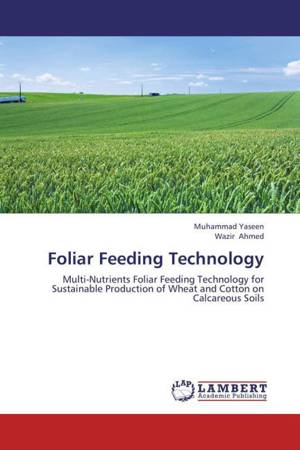
- Afhalen na 1 uur in een winkel met voorraad
- Gratis thuislevering in België vanaf € 30
- Ruim aanbod met 7 miljoen producten
- Afhalen na 1 uur in een winkel met voorraad
- Gratis thuislevering in België vanaf € 30
- Ruim aanbod met 7 miljoen producten
Zoeken
Foliar Feeding Technology
Multi-Nutrients Foliar Feeding Technology for Sustainable Production of Wheat and Cotton on Calcareous Soils
Muhammad Yaseen, Wazir Ahmed
Paperback | Engels
€ 66,45
+ 132 punten
Omschrijving
Deficiency of micronutrients in soils of arid and semi-arid regions (alkaline and calcareous soils) forms one of the major yield limiting factors and can greatly disturb plant yield and quality. Micronutrients availability in these soils is limited due to high pH, low organic matter, high calcium and magnesium, carbonate and bicarbonate contents. Soil application of micronutrients is very expensive under the prevailing soil conditions. The availability of added micronutrients to these soils is affected by the soil and environmental factors. Except Mo, most of micronutrients are readily fixed in soil having alkaline pH. So, plant roots are unable to absorb adequate amount of these nutrients from dry top soil. Foliar feeding is particular technique to supply macro and micro nutrients to avoid all the above factors and thus results in rapid absorption of these nutrients. It is generally more effective and less costly technique than soil application particularly where the soil conditions are not conducive for micronutrients availability. Our studies showed that it can increase wheat grain and seed-cotton yields from 25 to 35% than traditional application of fertilizers.
Specificaties
Betrokkenen
- Auteur(s):
- Uitgeverij:
Inhoud
- Aantal bladzijden:
- 96
- Taal:
- Engels
Eigenschappen
- Productcode (EAN):
- 9783848408337
- Verschijningsdatum:
- 20/06/2013
- Uitvoering:
- Paperback
- Afmetingen:
- 150 mm x 220 mm
- Gewicht:
- 150 g

Alleen bij Standaard Boekhandel
+ 132 punten op je klantenkaart van Standaard Boekhandel
Beoordelingen
We publiceren alleen reviews die voldoen aan de voorwaarden voor reviews. Bekijk onze voorwaarden voor reviews.








